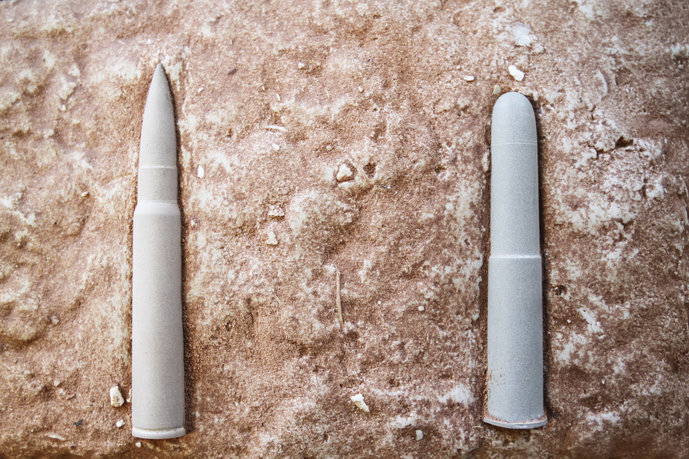

© Natalia Schmidt
The installation provides insights into the various research stages of the Ammunition Project, which began with the Paragrave (2012) object and together with the multimedia work, A Composition on Invisible Hands (2017), formed Natalia Schmidt's diploma.
Based on an archeology and genealogy of the German arms and ammunition production and the politically legitimate arms trade of the former DWM (German arms and ammunition factories), but also of today's arms concerns, the project deals with the technical, historical, political, legal, ethical and ecological conditions and consequences of arms and ammunition production.
Paragrave marks the legal position under which weapons were produced while questioning today's (neocolonial) conditions and their legitimation.
The M8 x 57 IS cartridge serves as the narrative guide for the composition. In its site-specific connection to Karlsruhe (DWM), both local and global dimensions of its lethal, historical and economic impact are combined: first manufactured in Karlsruhe in 1904, it has been and still is the prototype for the world's leading military and hunting cartridges involved in numerous international conflicts. The “work in progress” A Composition on Invisible Hands is based on musical interpretations of barcodes taken from different products and revolves around structures and mechanisms of economic logic and their existential effects. The bar codes heard in the piece (in the M8 x 57 IS variation) come from five countries (among others) in which this cartridge is still manufactured today: Germany, Serbia, Sweden, Czech Republic, USA.
On March 17, 2017, the temporary return of a DWM secret file from 1942-1944 to its place of origin - the former DWM - took place; the content of which the project also traces. At this point Paragrave questions the discrepancy between the archive and the antique trade.
Natalia Schmidt was born in Munich and studied media art and scenography at Karlsruhe University of Design from 2012/13 to 2017. Previously she studied art science, philosophy and cultural studies in Karlsruhe & Berlin with Prof. Boris Groys (HfG Karlsruhe) and Prof. Christina von Braun (HU Berlin). Her artistic work is conceptual and process-oriented and is often based on long-term research and observation. The boundaries between theory and practice blur. The choice of the artistic medium for the visual or spatial implementation arises from their respective conceptual concerns. Her projects attempt to evoke a sensory echo at the level of perception, especially in terms of time, duration, history, memory, geography, nature and climate. The moment of “unresolved” - and never redeeming history - is a central moment for the investigation of her diploma project: Ammunition Project: A Composition on Invisible Hands.